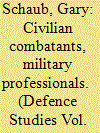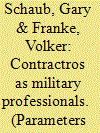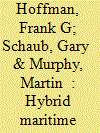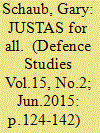| Srl | Item |
| 1 |
ID:
138288


|
|
|
|
|
| Summary/Abstract |
North Atlantic Treaty Organization (NATO) members such as Canada and Denmark have transformed their military forces to better engage in expeditionary warfare. They are incorporating advanced technologies to find and strike targets precisely from great distances at little risk to themselves. The persistence of unmanned aerial vehicles (UAVs) represents the next step in modern airpower’s long-range reconnaissance/precision strike complex and has transformed ground operations. Nonetheless, operational requirements in Afghanistan caught Canada and Denmark flat-footed. Ultimately, Canada effectively used UAVs while Denmark could not. Moreover, neither state has a UAV capability beyond small tactical systems (although each has plans to develop or join in the development of larger ones). The Canadian and Danish experiences suggest that ground forces are most likely to acquire and integrate small UAVs into their force structures and concepts of operation and that the air forces of small- and medium-sized Western countries will likely do so only in cooperation with others. It is here that the Canadian and Danish UAV paths may yet again cross.
|
|
|
|
|
|
|
|
|
|
|
|
|
|
|
|
| 2 |
ID:
099510


|
|
|
|
|
| Publication |
2010.
|
| Summary/Abstract |
States have increasingly replaced military personnel with armed civilian contractors. Are these civilians members of the military profession? I address this question in two ways. First, I assess whether armed contractors exhibit the characteristics of the profession of arms: expertise in the application and management of violence, provision of cost-effective solutions within the jurisdiction of warfare, legitimacy derived from the state and polity, and a recognized corporate identity. Then I assess the views of 260 elite American field grade officers. I find that armed contractors do share many of the characteristics of military professionals but that officers do not view the civilian contractors as military professionals, are uncomfortable with their intrusion into the profession of arms, and are cognizant of their negative effects but some ambivalence in their responses suggests that the boundaries of the profession of arms are being permeated by civilian contractors acting in combat roles.
|
|
|
|
|
|
|
|
|
|
|
|
|
|
|
|
| 3 |
ID:
094715


|
|
|
| 4 |
ID:
152642


|
|
|
|
|
| Summary/Abstract |
Russia’s use of hybrid warfare techniques has raised concerns about the security of the Baltic States. Gary Schaub, Jr, Martin Murphy and Frank G Hoffman recommend a series of measures to augment NATO’s Readiness Action Plan in the Baltic region, including increasing the breadth and depth of naval exercises, and improving maritime domain awareness through cooperative programmes. They also suggest unilateral and cooperative measures to develop a sound strategic communications strategy to counter Moscow’s information operations, reduce dependence on Russian energy supplies and build the resilience of critical undersea and maritime infrastructure. Finally, the article proposes that more attention be devoted to resolving unsettled maritime boundaries between Latvia and Lithuania, and between Denmark and Poland, to reduce the chance that these can be exploited to increase regional instability as part of a larger hybrid campaign.
|
|
|
|
|
|
|
|
|
|
|
|
|
|
|
|
| 5 |
ID:
139207


|
|
|
|
|
| Summary/Abstract |
Canada owns and uses unmanned aerial vehicles (UAVs), but its military services have acquired and integrated them into their force structure and operations with different degrees of ease. Service differences are explained with a three variable innovation adoption framework that integrates cost, impetus, and disruptive nature. The Army and Navy framed UAVs as relatively inexpensive adaptive innovation that would help avoid operational failures. The Air Force framed UAVs as expensive disruptive innovation that could improve performance of core functions but experienced UAVs as inexpensive adaptive innovations that helped avoid operational failure; yet these successes were perceived as inadequate. Analyzing services captures processes that national studies miss.
|
|
|
|
|
|
|
|
|
|
|
|
|
|
|
|